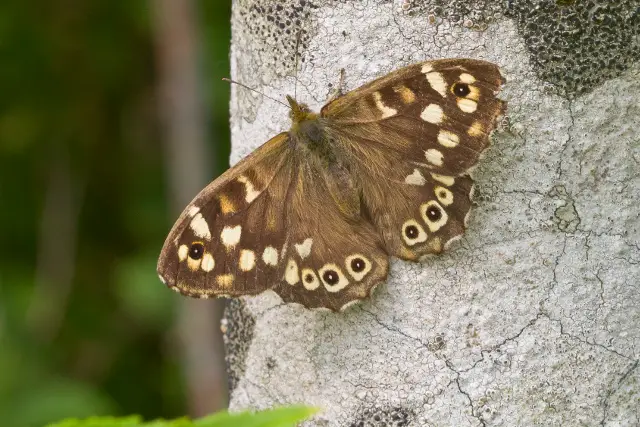Katie shares this latest news from Butterfly Conservation. Ed
If You Go Down To The Woods Today.…..
Wildlife lovers are being asked to head into the woods this summer to help chart the progress of an unprecedented butterfly success story.
The Speckled Wood has experienced an extraordinary a 71% increase in distribution and 84% increase in abundance in the last 40 years as a result of the changing climate.
This increase comes at a time when more than three quarters of UK species are in a state of decline with many widespread butterflies also experiencing worrying slumps.
Climate change
The Speckled Wood’s extraordinary rise appears to be due to climate change. As the UK’s climate has warmed the butterfly has spread to colonise East Anglia, the Midlands and much of northern England.
The butterfly has also become much more widespread in Scotland where in the 1970s it was restricted to the mildest areas on the west coast and the Moray Firth.
As part of this year’s Big Butterfly Count, Butterfly Conservation (BC) and the Tree Charter, a campaign to help protect the UK’s woodlands and wildlife, are asking the public to look out for and record the Speckled Wood in our woodlands.
Results from the Big Butterfly Count will track the ongoing spread of the butterfly in the UK and help scientists to understand why the Speckled Wood has thrived when so many other species have seen their fortunes falter.
Where to find the Speckled Wood
The aptly named Speckled Wood flies in partially shaded woodland with dappled sunlight. The butterfly’s spread has been limited in parts of the UK where woodlands have been destroyed.
As well as a key habitat for the Speckled Wood, woodlands are important for many butterflies including threatened species such as the Pearl-bordered Fritillary, Wood White and Black Hairstreak as well as widespread Count species such as the Ringlet, Brimstone, Comma and Holly Blue.
Woodland Counts will help Butterfly Conservation (BC) build a clear picture of the importance of these habitats to widespread species.
Attenborough: “We need more information”
BC President Sir David Attenborough said,
“The sight of a Specked Wood flitting through the dappled sunlight of woodland glade is a memorable high summer spectacle.
“We need more information about how widespread species are faring in this vitally important butterfly habitat. Sadly, our woodlands face a multitude of threats from habitat loss to climate change and various tree diseases. Spend 15 minutes counting butterflies in your local woodland and help us build a picture of how we can help protect woodland butterflies.”
BC Head of Recording Richard Fox said,
“Sadly, the Speckled Wood is one of relatively few butterflies that have fared well over recent decades.
“As well as being a welcome new addition to woodlands and gardens in many parts of the UK, the butterfly provides a fantastic opportunity to study the impact of climate change on our native species. Not only has the Speckled Wood spread northwards, it has become less dependent on dense woodland and has even evolved greater flight abilities.
“Woodlands are vital for many butterfly and moth species as well as being beautiful places to explore and discover nature. Last year only 4% of Big Butterfly Counts took place in woodland. This summer let’s all try to do an extra Count in a local wood. A woodland Count will boost coverage of this special habitat and help us understand how common butterflies are faring in our woods.”
Take part in the count
The Count runs to 7 August. Taking part in the Count is very easy – find a sunny spot and spend 15 minutes counting the butterflies you see and then submit sightings online or via the free Big Butterfly Count app.
Our woods and trees are facing unprecedented pressures from development, disease and climate change; they risk being neglected, undervalued, and forgotten.
The Tree Charter is calling on people to help create a new Charter for Trees, Woods and People.
Matt Larsen-Daw, Project Lead for the Charter for Trees, Woods and People said:
“The mesmerising sight of fluttering gossamer wings through dappled sunlight is one of the experiences most guaranteed to lift the spirits on a summer walk in a woodland, and it is a beautiful living indication of a healthy functioning woodland ecosystem.
“Many species of butterflies and moths depend on the existence of healthy woods of specific types, and if we want to ensure future generations can enjoy these natural wonders in years to come we must ensure such woodlands are protected and well managed in the future.”
Image: © Ivan Lynas, Butterfly Conservation





